The junior year experience of the fifties
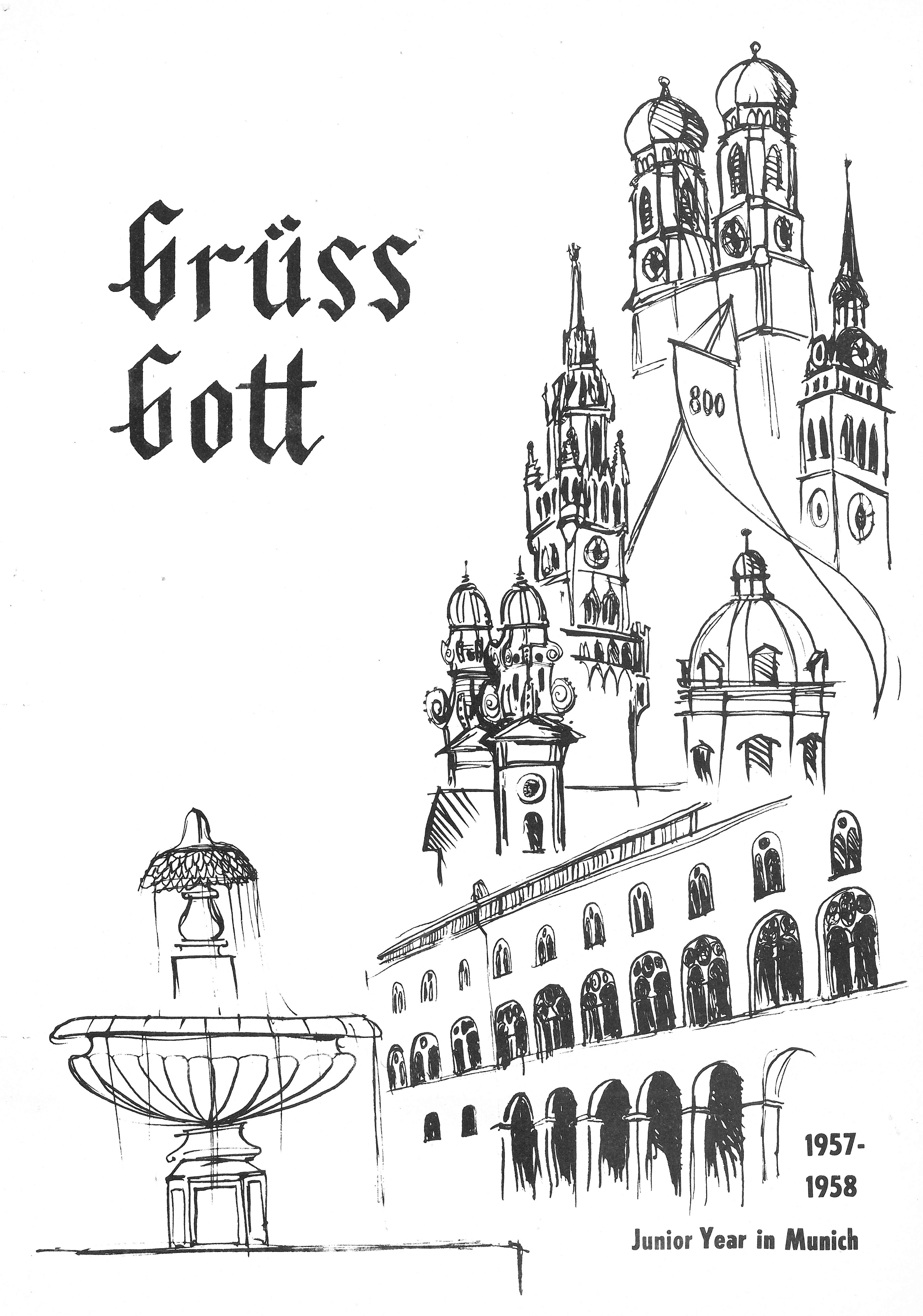
Eleanor (Wahlbrinck) Oliver (JYM 1957-59) shares her detailed study abroad memories of a long-gone era in Munich, where she spent her junior and senior year with JYM.
She studied art and German and happened to be the illustrator of the Grüss Gott 1957-58 yearbook from her first year. We are pleased to share her wonderful illustrations from that publication.
My choices for attending college were limited to the hometown college. Yes, it was a university and it was huge, 30,000 students at that time, but they were mostly local folks who were working full time on the assembly lines of the auto plants or returning servicemen using their GI Bill to be the first in their family to attend college. Detroit was a busy place in the postwar years. Everybody worked and every day produced. I was planning on a career in industrial design.
Freshman orientation was just one more thing to get out of the way before classes started. I remember sitting in an auditorium as one administrator after another droned on. Then a soft-spoken professor from the German Department, Dr. John Ebelke, stepped up and quietly began describing the most fantastic idea in the world. Study abroad!
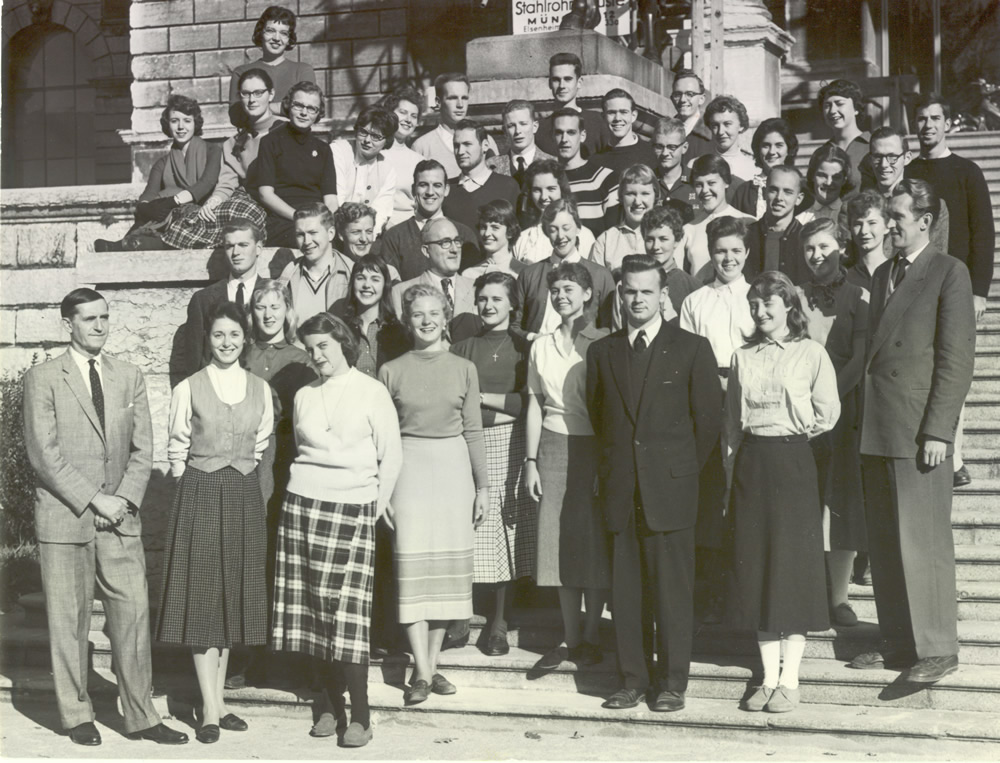
He explained how some students attended WSU without setting foot on campus in Detroit. During their junior year, they attended and took all their courses at the Ludwig Maximillian University in Munich! Wait, wait, say that again?! Junior Year in Munich?! Where do I sign up?
The basic requirement was four semesters of German (or its equivalent.) When the orientation session ended I dashed right back to Old Main and changed my foreign language from French 101 to German 101. I did have questions, though. These were still the post-war years. Wasn't Germany still in ruins? Where would I live? What would we eat? Did I have to pack the entire year's worth of clothes? I knew I could probably get care packages – would my mother have to send me toilet paper? But wait, I'm getting ahead of myself. I was an art major, where would I study to continue my major? The Kunst Akademie! Oh, that sounded so intense: so Blaue Reiter, so Bauhaus, so Albrecht Dürer! The next two years were focused on making this a reality.

The day finally arrived. I climbed into a train bound for New York City and a pier where Queen Elizabeth I was waiting. It was just like in the movies. Well, almost. Tourist class on the Queen was nothing like those fancy staterooms in the movies from the 1930s. I shared a snug cabin with three other JYMers, but our anticipation was boundless.
Our letter of instruction directed us to gather for our first orientation on the rear of one of the main decks where the Junior Year had reserved a group of deck chairs. Here, we met the resident director for our year in Munich, Dr. Eitel Dobert, from the University of Maryland. Dr. Dobert was a casually aristocratic gentleman with sharp dark eyes that, we soon learned, didn't miss very much. He was genuinely interested in assuring us that we would have the best overseas experience that JYM could provide.
Thanks to the efforts of Dr. Ebelke, who himself had been a junior year student in Munich during the 1930s, the Junior Year in Munich became the first undergraduate foreign study program available to American college students after World War II. He had convinced Wayne State University to sponsor this program and for so many of us, it put WSU on the map! Thank you Wayne State! Thank you Dr. Ebelke!
If you grow up in the grime of the industrial Midwest, you have no idea what the night sky looks like until you are on the deck of a ship in the middle of the Atlantic Ocean! You have no idea of the emptiness and the vastness of the sea and how excited you can get when you see a point of light in the distance and then realize that you will never know what the source of that light is as it disappears in the opposite direction. We did pass the Queen Mary and there was much hoopla and the sounding of horns. We frantically waved, and I'm sure the passengers on the HMSQM frantically waved back, but unless you had binoculars there wasn't much to see.
We anchored in the English Channel off the coast of Cherbourg where a tender was waiting for all of the passengers who would be taking the boat train to Paris. That included us. We crowded the railings and watched as everything headed for Paris – luggage, freight, mail – was lifted out of the hold and lowered to the deck of the tender. Finally, it was our turn and the gangway for passengers was extended and we climbed down. Dr. Dobert did his best to keep his little flock of eager American kids together. We were hustled onto a train, a European train, that looked nothing like the train that took me from Detroit to New York at the beginning of this adventure. It had compartments!
Once settled into one of these compartments I heard my first foreign language, French, the language I had rejected so casually during freshman orientation two years earlier. I had completely forgotten that. Now it sounded, well, foreign! People were pushing carts along the train platform and selling everything edible and drinkable. I can still hear the young woman who looked right at me and shouted "Sond-Weetch!" But I was so excited I couldn't have eaten anything. It never crossed my sober little American mind to buy a bottle of wine. No one would have asked to see I.D. and no one informed us that the legal drinking age in France was probably two! Bottled water was also a phenomenon. What was wrong with tap water? In post-war Europe, a lot!
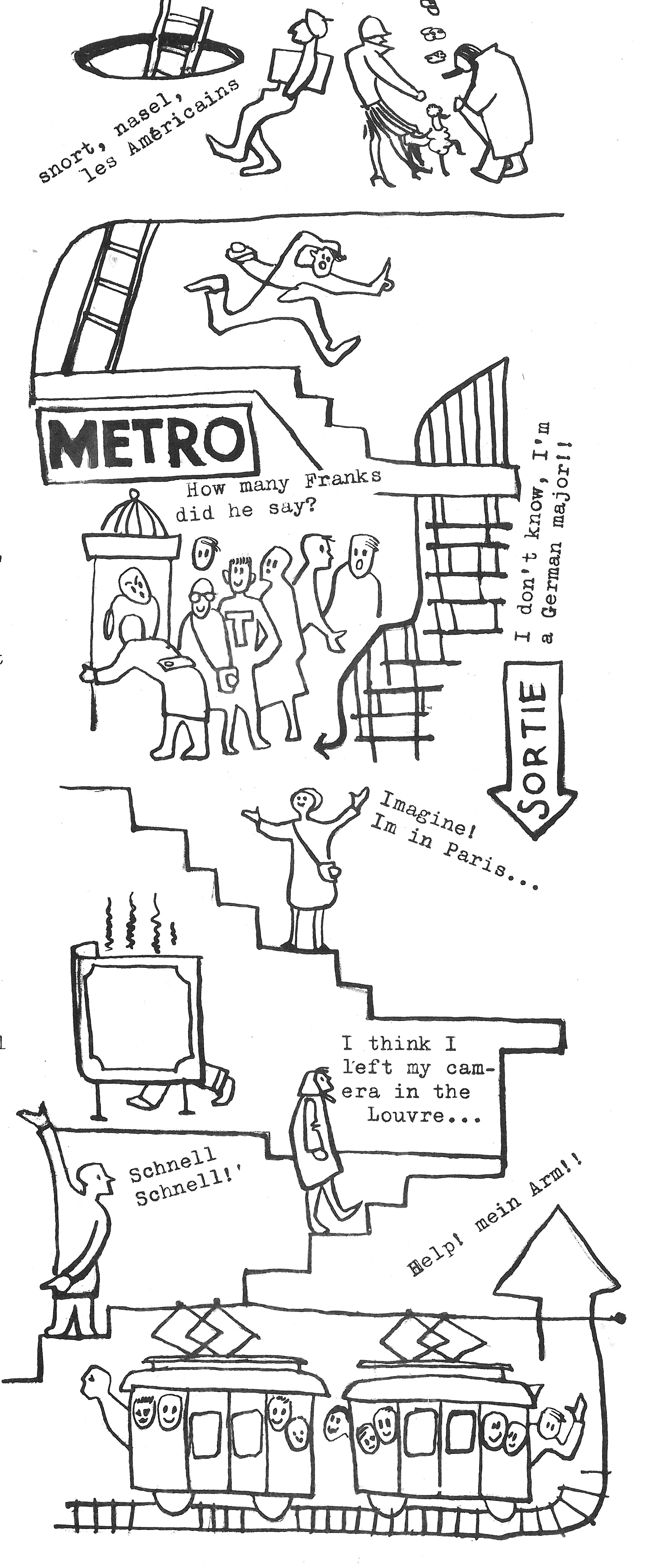
Inspired by a visit to Paris.
Paris, being quartered overnight at the Cite Universitaire, and visiting Versailles are all a pleasant blur. I do remember boarding the Orient Express! at the Gare du Nord and half expecting Agatha Christy or Inspector Poirot to be looking by the window of the train compartment in terror as we swarmed through the train looking for window seats. We were an excited bunch of self-assured Americans. This was post-war Europe. It would take a hard-working, hard-partying, internationally cosmopolitan city like Munich to create that life-altering experience for each of us.
We returned to the United States changed thanks to Munich, to JYM and to one year of effort on the part of many caring people from Resident Director, Herr Dr. Dobert, to a dedicated staff of tutors and instructors and Herr Hildebrandt (Hildy) the office manager who spoke no English, or so he claimed, to the Hausvater of my dorm in the Kaulbachstraße, Herr Marchl. His massive German Shepherd snarled at all the males who approached the front desk. The dog was always muzzled, but Herr Marchl claimed that after 10 p.m. when all visitors were to be out of the building, the muzzle was removed. The dog was never challenged. The gentlemen were out on time (or more likely stayed the night.)
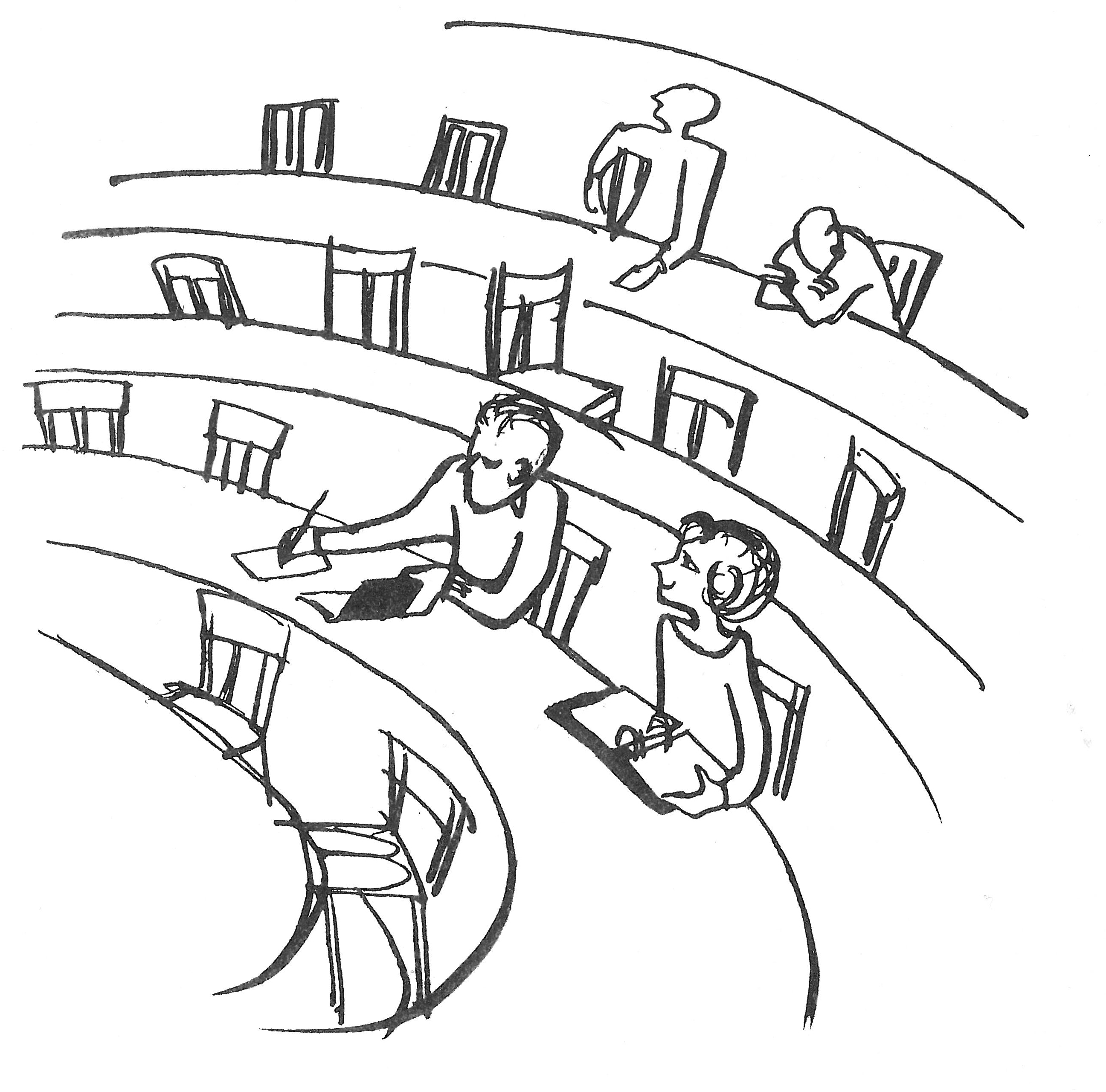
Vorlesungssaal an der LMU.
I was struck by how mature the German students were. Some wore what looked like wedding rings, which I learned were just engagement rings because in Germany a wedding ring would be worn on the right hand. They could get by with very little. Their rooms were spartan, their wardrobes basic. Some of the women in my dorm would be seen in the same few outfits week after week. Living in Germany in 1957 was a very economical endeavor. JYM had three monthly allowance plans: $75 per month (the plan I was on), $90, or $120 per month for the big-time spenders. I would have liked a little financial wiggle room but I had to convince my Dad that a year in Munich would be less expensive than spending a year at Wayne State and living at home. I learned a lot more than German that year.
For $75 per month, I was settled into a women's dormitory, while the $120 crowd lived in rooms rented in private homes and possibly furnished with the finest Biedermeier Furniture. In the end, I think I had the better deal. The landlady of the rented room may have been the nicest person in the world, but she was still just the landlady and your greatest interaction would have been handing her your monthly rent. Meanwhile, I was meeting all kinds of young German women and an assortment of foreign students as well.
Every student regardless of language skills had to take their turn at the front desk from 6 until 10 p.m. That meant handing people their mail, making change for the telephone, collecting money for the use of the bath. A shower was free but a tub full of hot water costs a few marks. And then there was answering the telephone. There was one telephone for the entire floor and it was right outside my room. Guess who was given the privilege of answering it or listening to it ring incessantly? No one ever called me, but for one whole year, I was the receptionist for the entire second floor of the Marie-Antonia Studentinenheim. This was pure terror until I learned to ask the person on the other end to speak more slowly because I was a foreigner. I'm sure they recognized my accent even though I did not.
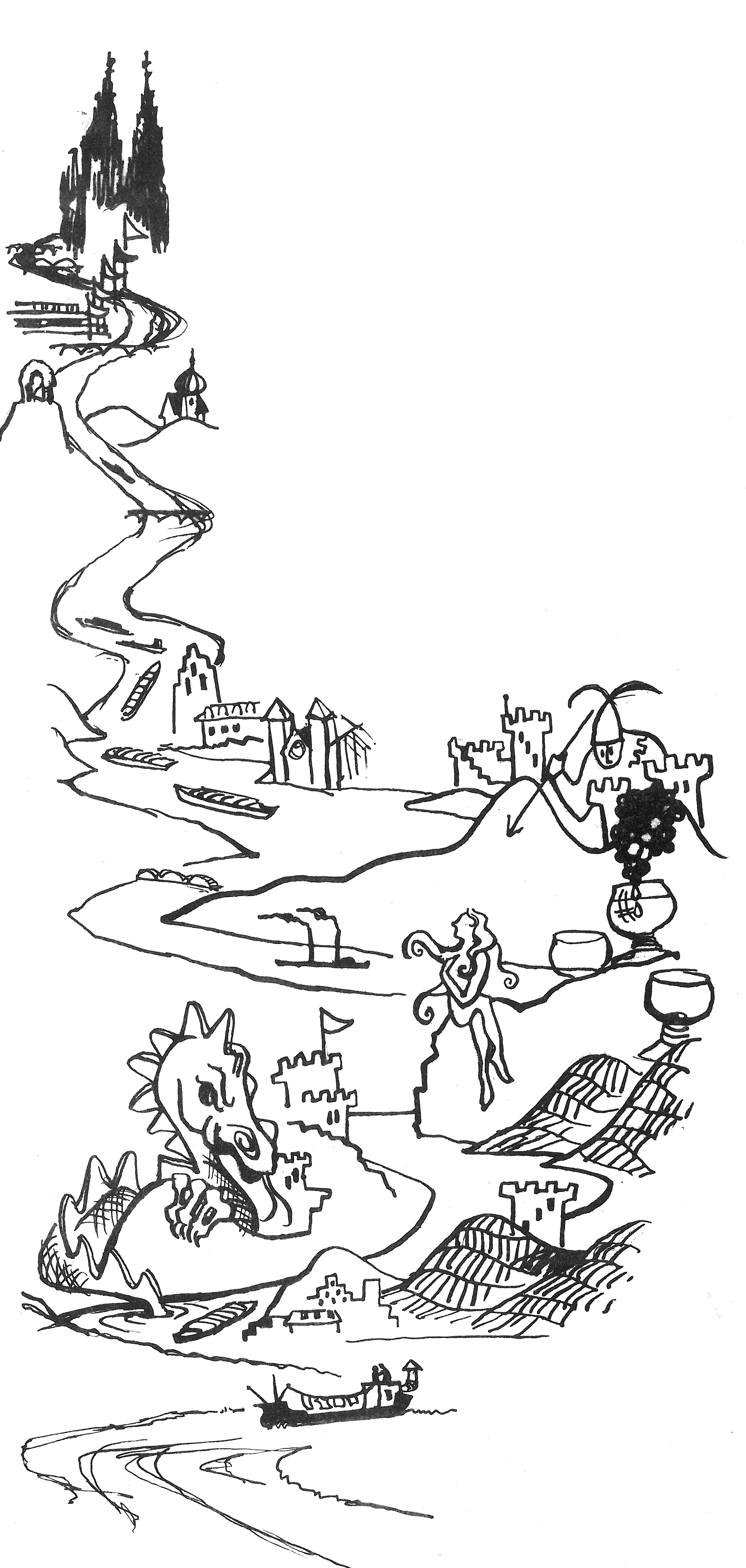
Inspired by Rheinland
I was also able to spend my senior year in Munich as a fully matriculated WSU student. The trick was to find enough courses in the Ludwig Maximillian University catalog to fulfill the English requirement and the physical education requirement for my B.A. I found a ladies fencing class in a community Sport Halle where everyone fenced right-handed, even the left-handers, except me, a lefty. That was where I learned that fencing was one of the few times in Germany that left-handedness was to my advantage.
I understand they are not so rigid anymore, but back then, the Germans loved to watch me write and draw. Mostly they were polite about it except for one of the interns at the Kunst Akademie who wanted me to make a lot of little figures on the same page to save paper. Finally, he realized I was left-handed, and that was probably why I was having difficulty following his instructions. He scolded me in front of the entire class. My German was not yet good enough to defend myself. I was not embarrassed about being left-handed but about not being able to talk back to the dullard-yet!
Munich no longer lay in ruins by 1957, but you did not have to look too far to see where they had been. Buildings were neatly divided into Altbau and Neubau The Junior Year Hq. – a small former storefront in the Amalien Str. – was an Altbau. It was a charming example of Bavarian Jugendstil, badly blackened by fire. The building had apartments above, one toilet per floor at the end of the hallway, and a very dimly lit hallway, but it was also just steps away from the rear entrance of the Uni.
The buildings across the street were clearly Neubau: clean, uncluttered, mostly stucco. They were built of a type of block with standardized windows and were heavily influenced by the Bauhaus school and economic building methods. They housed a huge bookstore where we bought endless copies of Reclam-Hefte! Further down the block was the notorious Cafe Schneller, run by Frau Schneller who wrung every drop of coffee out of her filtered coffee grounds and every penny out of her customers.
German cities had a certain "sameness" to them at that time, in part because they had gotten rid of the signs of destruction. More subtle signs were pointed out to us by our instructors. On the side of the Feldherrn Halle, there were still four holes left in the stone where a memorial plate had once been bolted down. The plate had listed the names of a group of Hitler's supporters who had been killed on that spot during some early demonstrations. Herr Dr. Reh explained that two brown-shirted party members had always stood guard and that everyone who walked by had been forced to stop and salute. Across the street from this offensive site was the beautiful façade of the Theatinerkirche. That it survived the war must have been a miracle. These contrasts were everywhere.
I was not a great fan of beer so I only visited the Oktoberfest and the Hofbrauhaus a time or two. So I will leave stories about them to others who spent a greater part of their coming of age in Munich at such institutions. I was more likely to be found almost any Saturday at the Viktualienmarkt or the Blumenmarkt. One afternoon I took a shortcut home down the Fleischergasse. Yes, there were still a few butcher shops there, but I also discovered the nicest shop of hand-carved Oberammergauer Manger figures. On my allowance, I could only afford the holy family and the stall to house them, and I sent the figurines to my folks for Christmas. Gradually I was able to assemble the entire creche including quite a little flock of sheep. They really add up when you send everyone a few sheep at every birthday. My grandchildren have the creche today and it has become a family ritual to carefully unpack it and set it up on the first Sunday of Advent every year.
I made great friends during my time in Munich, some of whom I still correspond with and visit today. For almost 65 years, these friendships have helped keep my German language skills alive. Thanks to the invention of email, the exchanges are now often daily. Some JYMers from the Class of '57 and "58 and some Germans from that timeshare a weekly blog called the Word of the Week. When I can't find a German word to have fun with, I'll simply post a picture.

German and Germany also influenced my family life. I met my husband at a Deutscher Abend sponsored by a young people's group at a large downtown church in Washington DC. He was another American who had learned German while being stationed there. My children were lucky to attend a public high school here in Washington D.C. that had a German teacher on the faculty who loved her work.
After high school, they all went to German-speaking countries for a year through American Field Service. Not by design but by great good fortune German became the second language and culture of our family. It all started with Dr. John Ebelke convincing me to spend my junior year in Munich!